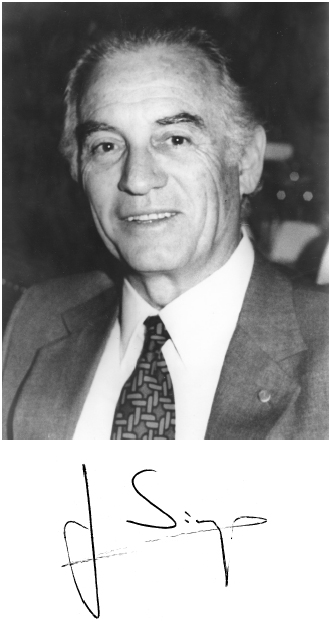
1923–2009
Elected in 1981
“For contributions to knowledge of stability of reinforced thin-walled structures, international cooperation in mechanics, and design of Israeli aircraft.”
BY DANIEL WEIHS
JOSEF SINGER, former president of the Technion–Israel Institute of Technology and founding faculty member and former dean of the university’s Faculty of Aerospace Engineering, died on November 12, 2009, in Israel.
Josi, as everyone called him, was born in Vienna on August 24, 1923, the second of two sons (his older brother Michael was a well-known painter), to Zvi and Erna (née Isler) Singer, who had a jewelry business. The family moved to Berlin in 1929 and left in 1933, as the Nazi regime started its antiSemitic actions, for what was then Palestine, settling in Haifa. Young Josi showed an early interest in aeronautics, joining the AeroClub where he became an instructor in 1940 and, upon reaching the minimal required age in 1941, received one of the first pilot’s licenses in Palestine. He then volunteered to serve in the British war effort, as a cadet pilot and mechanic in the Royal Air Force. After the war, he joined the air branch of the Jewish underground defense forces, Hagana (which later became the Israeli Defense Forces).
He studied aeronautical engineering at the Imperial College London, earning his (first-class) BSc and DIC in 1948 and then, after several years as a technical officer in the Israeli Air Force (which he left with the rank of major), got his MSc in 1953 and PhD in 1957 from the Polytechnic Institute of Brooklyn (now the Polytechnic Institute of New York University, or NYU-Poly), under the supervision of Nicholas Hoff.
Josi was a founder of the Department of Aeronautical Engineering at the Technion, promoted to associate professor in 1961 and full professor in 1965. He was one of the designers of the unique “level engineer” concept, in which undergraduates got basic and advanced courses in a wide range of disciplines, as—this being (then and still) the only school of aeronautical engineering in Israel—its graduates had to be able to work in all disciplines. This unique approach, which was hard on the students, proved its value as the graduates from this department went on to found the highly successful Israeli aerospace industry, which is one of the top employment and export sectors of Israel. He served as dean of the Department of Aeronautical Engineering twice (1958–1960 and 1965–1967), including during the Six-Day War, in which air superiority was instrumental in bringing about rapid victory. This superiority was supported by engineers led by Josi, who had to improvise under the French embargo on aircraft and spare parts. He was subsequently elected president of the Technion and navigated the university through tough times from 1982 to 1986, in which the Israeli economy suffered triple-digit inflation.
Dr. Singer was a world-renowned expert on the design and applications of thin-walled structures, specializing in the phenomenon of buckling, in which a thin-walled plate or shell (such as an aircraft fuselage) suddenly collapses under compression. He authored over 100 research papers and was the lead author of the authoritative book Buckling Experiments, which appeared in two volumes, the first in 1987 and the second after his retirement, in 2000. Many of his graduate students became senior professors and engineers, in Israel and the United States.
As part of the post–Six-Day War push toward technological independence, Josi was seconded to the rapidly developing Israel Aircraft Industries (IAI), where he served as senior vice president and managed the engineering division from 1971 to 1973. He was responsible for all developmental projects and managed more than 1,500 people, most of them engineers. He pioneered the development of avionics; the Kfir fighter and the Commodore executive jet were some of the major projects
initiated in those years. He was also a member of the board of directors for several years and at one point pro tem chairman of the company, which experienced phenomenal growth on his watch. In 1986 he was appointed chairman of the IAI board of directors, a position he held until 1988.
Josi had an extremely high standing in the international aeronautical engineering community, as indicated by his election to the presidency of the International Council of Aeronautical Sciences. This was no mean feat, being an Israeli in an organization that was affected by the political situation in the Middle East. In addition, among numerous professional honors bestowed on him were election as a foreign associate of the US National Academy of Engineering, member of the International Academy of Astronautics, foreign member of the French Air and Space Academy, and fellow of the American Institute of Aeronautics and Astronautics (AIAA) and Israel Society of Aeronautics and Astronautics, of which he was a founding member and long-time president.
He was honored with the International Council of the Aeronautical Sciences (ICAS) Maurice Roy Medal (1990), the Ludwig Prandtl Ring (1994), and the Wilhelm Exner Austrian medal (1994). As an NYU-Poly graduate, he was awarded in 2005 the school’s Sesquicentennial Medal for his work in aeronautics and his leadership as president of the Technion. He also received honorary doctorates from Aix-Marseille University and the University of Glasgow.
Josi was an extremely personable man, a true gentleman of the Austrian tradition. He had many friends among his scientific colleagues all over the world, and was an ardent promoter of younger scientists and engineers (present writer included), always with an objective and kind word of advice based on experience. He was a wonderful family man to his wife, children, and grandchildren. He is sorely missed by all.




